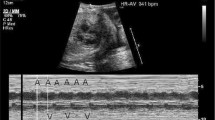Summary
Supraventricular tachycardia is the most frequent form of symptomatic tachydysrhythmia in infants, children, and adolescents. Clinical symptoms depend on age and underlying cardiac anatomy. Newborns and infants with paroxysmal supraventricular tachycardias like atrioventricular reentrant tachycardia due to an accessory atrioventricular pathway and atrioventricular nodal reentrant tachycardia present with signs of acute congestive heart failure; in school-age children and adolescents palpitations are the leading symptom. In patients with chronic-permanent tachycardia as atrial ectopic tachycardia and the permanent form of junctional reciprocating tachycardia, the dysrhythmia is present >>;80% of the day resulting finally in a secondary form of dilated cardiomyopathy, the so-called „tachymyopathy” with cardiomegaly due to dilatation of the left ventricle and significant impairment of left ventricular systolic function.
Therapy of tachycardia episodes has to be guided individually by the clinical situation and age of the patient, duration of the tachycardia, and underlying cardiac anatomy. In severe hemodynamic compromise or if the presence of ventricular tachycardia is suspected tachycardia should immediately be terminated by external cardioversion (1–2 J/kg) during deep sedation with ketamine (1–2 mg/kg). Vagal maneuvers are effective in patients with atrioventricular reentrant tachycardias where the AV-node forms a critical part of the reentrant circuit. Adenosine (0.1–0.3 mg/kg) is the drug of first choice in any age group. Advantages over other antiarrhythmic drugs include the short half-life of the substance (<2 s) and minimal or absent negative inotropic effects. In patients with wide QRS-complex tachycardia adenosine may safely be administered in contrast to verapamil. Intravenous application of verapamil in newborns and infants is contraindicated because of the high risk of electro-mechanical dissociation. In older children and adolescents, verapamil (0.1 mg/kg) may safely be administered with the restrictions as in adult patients (wide QRS-complex tachycardia, significant hemodynamic compromise).
Spontaneous cessation of tachycardia activity can be expected in the majority of newborns and infants during the first year of life. Due to this excellent prognosis pharmacological control of tachycardia activity is advised in these young patients until spontaneous tachycardia cessation. In older children, however, spontaneous cessation of tachycardia activity is rare. Radiofrequency catheter ablation of the anatomical substrate with its curative option is therefore a rational alternative to long-lasting antiarrhythmic drug treatment in those patients.
Antiarrhythmic drug therapy is performed on an empirical basis in young patients. Digoxin may safely be given in all forms of supraventricular tachycardia in which the AV-node is involved in tachycardia perpetuation except in patients with preexcitation syndrome >>;1 year. In patients with atrioventricular reentrant tachycardia class 1c drugs like flecainide and propafenone are effective to control the tachycardia in >>;85% of the patients. Due the proarrhythmic potential of the modern antiarrhythmic drugs, classical β-blocker therapy has been advocated. Dl-sotalol is highly effective in young patients with atrioventricular reentrant tachycardia as well as in primary atrial tachycardia like atrial flutter. Amiodarone exerts the highest antiarrhythmic potential. Due to its high rate of systemic and electrophysiological adverse effects, the drug should be used with restriction.
In school-aged children and adolescents radiofrequency catheter ablation of the anatomical substrate of the tachycardia is an attractive alternative to long-lasting antiarrhythmic drug therapy. The success rate with permanent cessation of the tachycardia approaches 90% in patients with accessory atrioventricular pathways and atrioventricular nodal reentrant tachycardia as well as in children with forms of chronic permanent tachycardias. In patients with supraventricular tachycardia and complex congenital heart disease, catheter ablation during preoperative cardiac catheterization seems to be the rational therapeutic approach.
Despite the clear advantages of radiofrequency catheter ablation, the procedure should be performed only with unquestionable indication in young patients, as morphological and electrophysiological sequelae of radiofrequency current application at growing atrial and ventricular myocardium during long-term follow-up are still unknown.
Similar content being viewed by others
Author information
Authors and Affiliations
Additional information
Received: 23 January 1999 Accepted: 11 November 1999
Rights and permissions
About this article
Cite this article
Paul, T., Bertram, H., Bökenkamp, R. et al. Diagnosis and management of supraventricular tachycardia in infants and children. Herzschr Elektrophys 10, 235–247 (1999). https://doi.org/10.1007/s003990050071
Issue Date:
DOI: https://doi.org/10.1007/s003990050071




